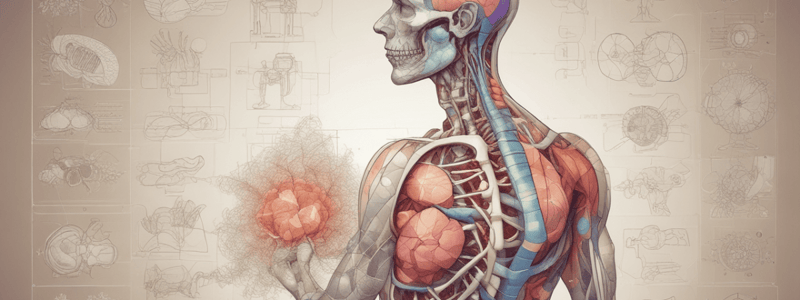Podcast
Questions and Answers
What percentage of calcium in the body is found in the bones and teeth?
What percentage of calcium in the body is found in the bones and teeth?
- 40%
- 55%
- 1%
- 99% (correct)
Which of the following forms of calcium is physiological active?
Which of the following forms of calcium is physiological active?
- Calcium in complexes with citrate and bicarbonate
- Calcium in bone
- Calcium bound to proteins
- Free ionized $Ca^{2+}$ (correct)
Which of the following is NOT a good source of calcium?
Which of the following is NOT a good source of calcium?
- Oysters
- Potatoes (correct)
- Ice cream
- Spinach
In what form is approximately 40% of calcium found in the extracellular fluid?
In what form is approximately 40% of calcium found in the extracellular fluid?
Where is calcium primarily absorbed in the body?
Where is calcium primarily absorbed in the body?
How much calcium is generally found in soft-tissue cells and extracellular fluid combined?
How much calcium is generally found in soft-tissue cells and extracellular fluid combined?
Flashcards are hidden until you start studying
Study Notes
Calcium in the Human Body
- The human body contains approximately 1-1.3 kg of calcium, with 99% found in bones and teeth.
- The remaining 1% is distributed between soft-tissue cells and extracellular fluid (interstitial fluid and blood plasma).
Forms of Calcium in Body Fluids
- 55% of calcium in body fluids is in the form of free ionized Ca²⁺, which is physiologically active.
- 40% is bound to proteins, mainly albumin, and is physiologically inactive.
- 5% is complexed with citrate and bicarbonate.
Calcium Distribution in the Body
- 99% of calcium is found in the skeleton.
- 1% is found in soft tissue.
- 0.1% is found in extracellular fluid.
Calcium in Extracellular Fluid
- 55% of calcium in extracellular fluid is ionized calcium (Ca²⁺, ~1.5mM).
- 40% is protein-bound calcium.
- 5% is complexed calcium (Ca-bicarbonate, Ca-citrate, Ca-lactate, Ca-phosphate).
Calcium Sources
- Good sources of calcium include milk and milk products, oysters, salmon, spinach, ice cream, broccoli, and oranges.
Calcium Absorption
- Calcium is absorbed in the intestine from dietary sources such as calcium phosphate, carbonate, tartrate, and oxalate.
Studying That Suits You
Use AI to generate personalized quizzes and flashcards to suit your learning preferences.




